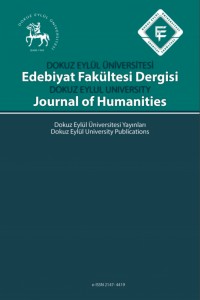Öz
Bu makalede Theodor Adorno’nun “George-Hofmannsthal Mektuplaşması” denemesi incelenmekte ve Adorno’nun yapıtlarında edebiyat sosyolojisi ile estetik kuram arasındaki bağlantı ele alınmaktadır. Stefan George’nin şiirleri Adorno’nun felsefesinde önemli bir yer tutmaktadır, fakat bu mektuplaşmalara dair denemesinde “Lirik Şiir ve Toplum Üzerine” gibi denemelerinden farklı olarak Stefan George ve Hugo von Hofmannsthal’ın toplumsal ve politik konumlarının sosyolojik analizine de ağırlık vermektedir. Bu nedenle “George-Hofmannsthal Mektuplaşmaları” Adorno’nun daha sonra Estetik Kuram’da ortaya koyduğu kuramsal çerçeveyi nasıl iki sembolist şairin eserleri ve hayatlarından soyutlayarak biçimlendirdiğini ortaya koymakta, Adorno’nun sosyal eleştiri ve estetik otonominin iç içe geçtiği metodolojisini aydınlatmaktadır.
Anahtar Kelimeler
Kaynakça
- Adorno, T. (1977). George und Hofmannsthal. Zum Briefwechsel: 1891-1906. Kulturkritik und Gesellschaft I. Gesammelte Schriften Vol. 10.1. Frankfurt am Main: Suhrkamp, s. 195-238.
- Adorno, T. (1991a). Culture industry reconsidered. The Culture Industry. New York, NY: Routledge.
- Adorno, T. (1991b). On Lyric poetry and society. Notes to Literature I. New York, NY: Columbia University Press, s. 37-54.
- Adorno, T. (1997). The George-Hofmannsthal correspondence: 1891 – 1906. Prisms. Trans. by Samuel and Shierry Weber. Boston: MIT Press, s. 187-227.
- Adorno, T. (1998). Aesthetic Theory. Minneapolis, MI: University of Minnesota Press.
- Bernstein, J.M. (1992). The Fate of Art: Aesthetic Alienation from Kant to Derrida and Adorno. Penn State University Press.
- Berman, R. (1999). Cultural studies and the canon: Some thoughts on Stefan George. Profession, 168–179. Erişim adresi: http://www.jstor.org/
- Fleming, P. (2004). The secret Adorno. Qui Parle 15.1, 97-114. Erişim adresi: http://www.jstor.org/
- Geulen, E. (2000). Endgames: Reconstructing Adorno's ‘End of Art’. New German Critique, 81, 153-168. doi:10.2307/488551
- Harding, J. (1992). Historical dialectics and the autonomy of art in Adorno’s Ästhetische Theorie. The Journal of Aesthetics and Art Criticism, 50.3, 183-195. doi:10.2307/431227
- Hohendahl, P. U. (1991). Reappraisals: Shifting Alignments in Postwar Critical Theory. Cornell University Press. Jameson, F. (1990). Late Marxism: Adorno, or, The Persistence of the Dialectic. London: Verso.
- Huyssen, A. (1975). Introduction to Adorno. New German Critique 6, 3-11. doi:10.2307/487649
- Miller, T. (2007). Modernism and the Frankfurt School. Edinburgh University Press, 2014.
- Plaas, U. (2007) Language and History in Theodor W. Adorno’s Notes to Literature. New York, NY: Routledge.
- Richter, G. (2006). Aesthetic theory and nonpropositional truth content in Adorno. New German Critique, 97, 119-135. Erişim adresi: http://www.jstor.org/
- Strathausen, C. (2003). The Look of Things: Poetry and Vision around 1900. University of North Carolina Press.
Öz
In this article I analyze Theodor Adorno’s essay “The George-Hofmannsthal Correspondence” to investigate the relationship between sociology of literature and aesthetic theory in Adorno’s works. While Stefan George’s poetry holds a significant place in Adorno’s philosophy, his essay on the correspondence differs from his other works on symbolism such as “On Lyric Poetry and Society," since it places heavy emphasis on the sociological analysis of the social and political positions of Stefan George and Hugo von Hofmannsthal. As such, “The George-Hofmannsthal Correspondence” displays the way in which Adorno abstracts his later theoretical framework in Aesthetic Theory from the work and life of the two symbolist poets. The essay’s oscillation between sociology and aesthetic theory, I argue, illuminates Adorno’s complex methodology in its entanglement of social critique and aesthetic autonomy.
Anahtar Kelimeler
Kaynakça
- Adorno, T. (1977). George und Hofmannsthal. Zum Briefwechsel: 1891-1906. Kulturkritik und Gesellschaft I. Gesammelte Schriften Vol. 10.1. Frankfurt am Main: Suhrkamp, s. 195-238.
- Adorno, T. (1991a). Culture industry reconsidered. The Culture Industry. New York, NY: Routledge.
- Adorno, T. (1991b). On Lyric poetry and society. Notes to Literature I. New York, NY: Columbia University Press, s. 37-54.
- Adorno, T. (1997). The George-Hofmannsthal correspondence: 1891 – 1906. Prisms. Trans. by Samuel and Shierry Weber. Boston: MIT Press, s. 187-227.
- Adorno, T. (1998). Aesthetic Theory. Minneapolis, MI: University of Minnesota Press.
- Bernstein, J.M. (1992). The Fate of Art: Aesthetic Alienation from Kant to Derrida and Adorno. Penn State University Press.
- Berman, R. (1999). Cultural studies and the canon: Some thoughts on Stefan George. Profession, 168–179. Erişim adresi: http://www.jstor.org/
- Fleming, P. (2004). The secret Adorno. Qui Parle 15.1, 97-114. Erişim adresi: http://www.jstor.org/
- Geulen, E. (2000). Endgames: Reconstructing Adorno's ‘End of Art’. New German Critique, 81, 153-168. doi:10.2307/488551
- Harding, J. (1992). Historical dialectics and the autonomy of art in Adorno’s Ästhetische Theorie. The Journal of Aesthetics and Art Criticism, 50.3, 183-195. doi:10.2307/431227
- Hohendahl, P. U. (1991). Reappraisals: Shifting Alignments in Postwar Critical Theory. Cornell University Press. Jameson, F. (1990). Late Marxism: Adorno, or, The Persistence of the Dialectic. London: Verso.
- Huyssen, A. (1975). Introduction to Adorno. New German Critique 6, 3-11. doi:10.2307/487649
- Miller, T. (2007). Modernism and the Frankfurt School. Edinburgh University Press, 2014.
- Plaas, U. (2007) Language and History in Theodor W. Adorno’s Notes to Literature. New York, NY: Routledge.
- Richter, G. (2006). Aesthetic theory and nonpropositional truth content in Adorno. New German Critique, 97, 119-135. Erişim adresi: http://www.jstor.org/
- Strathausen, C. (2003). The Look of Things: Poetry and Vision around 1900. University of North Carolina Press.
Ayrıntılar
| Birincil Dil | İngilizce |
|---|---|
| Bölüm | Makaleler |
| Yazarlar | |
| Yayımlanma Tarihi | 23 Nisan 2021 |
| Gönderilme Tarihi | 24 Ocak 2021 |
| Yayımlandığı Sayı | Yıl 2021 Cilt: 8 Sayı: 1 |


